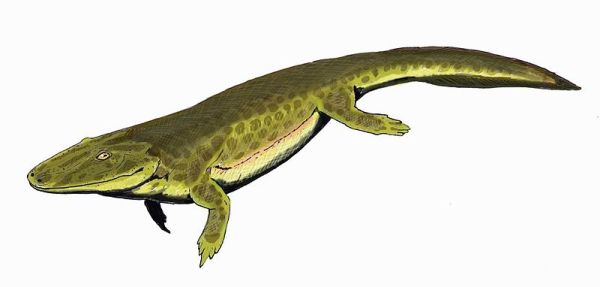
| Palaeos: |  |
Tetrapoda |
| The Vertebrates | Tulerpeton |
| Page Back | Unit Home | Unit Dendrogram | Unit References | Taxon Index | Page Next |
| Unit Back | Vertebrates Home | Vertebrate Dendrograms | Vertebrate References | Glossary | Unit Next |
|
Abbreviated Dendrogram
SARCOPTERYGII | TETRAPODA |--Acanthostega `--+--Ichthyostega `--+--Hynerpeton `--+--Tulerpeton `--+--Whatcheeriidae `--+--Crassigyrinus `--+--Colosteidae | `--Greererpeton `--+--Spathicephalus `--+--Baphetidae |--Eucritta `--Tetrapoda* |--TEMNOSPONDYLI `--+--LEPOSPONDYLI `--REPTILIOMORPHA |
Contents
Overview |
 Tulerpeton curtum, life reconstruction, by Dmitry Bogdanov. Wikipedia, GNU Free Documentation/Creative Commons Attribution |
Editor's note: due to lack of time and the need to fill out missing pages, this page has been copied with very little modification from Wikipedia. Some generic material has been excluded MAK111112
Tulerpeton is a fossil of an extinct genus of Devonian labyrinthodont that was found in the Tula Region of Russia at a site named Andreyevka. This genus and the closely related Acanthostega and Ichthyostega represent the earliest tetrapods
Tulerpeton is considered one of the first true tetrapods. It is known from a fragmented skull, the left side of the pectoral girdle, and the entire right forelimb and right hindlimb along with a few belly scales. This species is differentiated from the less derived "aquatic tetrapods" (such as Acanthostega and Ichthyostega ) by a strengthened limb structure. These limbs consist of 6 toes and fingers. Additionally, its limbs appear to have evolved for powerful paddling rather than walking.
The fossil fragments also indicate that its head was disconnected from the pectoral girdle. From the absence of the rough postbranchial lamina of the pectoral girdle, it has been determined that Tulerpeton had no gills and was therefore entirely dependent on breathing air.
Even though Tulerpeton breathed air, it lived mainly in shallow marine water. The Andreyevka fossil bed where it was discovered was at least 200 km from the nearest landmass during this era. The fossils of plants in the area tell us that the salinity of the waters where it lived fluctuated wildly, indicating that the waters were quite shallow. Because the bones of the neck and the pectoral girdle were disconnected, Tulerpeton could lift its head. Therefore, in shallow water, it had a considerable advantage over the other animals whose heads only moved side to side. The later land animals that descended from Tulerpeton’s relatives needed this head flexion on land, but the condition probably evolved because of the advantage that this gave it in shallow marine waters, not for land. In the book “Vertebrate Life”, authors Pough, Janis, and Heiser say that,” The development of a distinct neck, with the loss of the opercular bones and the later gain of a specialized articulation between the skull and the vertebral column (not yet present in the earliest tetrapods), may be related to lifting the snout out of the water to breath air or to snap at prey items.” The six fingered hands and toes were stronger than the fins from which they developed, therefore “tulerpeton” had an advantage in propelling itself through shallow and brackish water, but the limbs do not yet seem strong enough for extensive use on land.
Tulerpeton is one of the early transition tetrapods – a marine animal capable of living on land. The separation of the pectoral-shoulder girdle from the head allowed the head to move up and down, and the strengthening of the legs and arms allowed the early tetrapods to propel themselves on land.
Tulerpeton is important in the study of dactyly. The polydactyl (more than 5 toes) condition of Tulerpeton caused considerable comment when the fossil was first discovered. Before the discovery, the pentyldactyl, the 5-fingered condition that is ancestral to all living tetrapods, was thought to have developed before the first terrestrial tetrapods appeared. But the discoveries of Acanthostega and Ichthyostega confirm that the pentyldactyl ancestor came later in the development of tetrapods. Dnswitzer101104
Tulerpeton: curtum Lebedeu, 1984
Range: Fammenian (Latest Devonian) of Tula region, Eastern Russia
Phylogeny: Tetrapoda : Acanthostega + (Ichthyostega + (Hynerpeton + (Ossinodus + (Whatcheeriidae + (Crassigyrinus ::: Tetrapoda*))) + *.)))
Comments: Although Tulerpeton has, like Crassigyrinus, been placed with, or at the base of, the reptiliomorphs, the consensus now is that it represntes instead the early tetrapod lineage. Generally it is placed between Hynerpeton (as a contemporary but more primitive form) and early to mid Carboniferous Whatcheeriids, Crassigyrines, and Colosteids. In terms of the old order Ichthyostegalia, Tulerpeton represents a good transition form between the other late Devonian tetrapods and the Carboniferous amphibians proper MAK111112
References: Lebedev & Coates 1995, Gordon & Long 2004
Links: Devonian Times, Recent Transitionals, Tree of Life - Stegocephalians: Tetrapods and other digit-bearing vertebrates - Wikipedia 110831)
| Page Back | Unit Home | Page Top | Page Next |
Text content Dnswitzer101104 (and more recent updates on Wikipedia); page MAK111112
